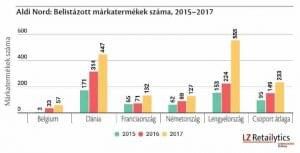Magazine: Supermarketisation vs. discountisation
 In order to give new momentum to their sales increase, leading discount store chains have stepped on the path of supermarketisation: they started introducing elements formerly characteristic of supermarkets only. This is especially true for Aldi, the global market leader discount store chain. Aldi decided to go in the direction of supermarkets in saturated markets and in those where the discount store format never managed to become attractive to shoppers.
In order to give new momentum to their sales increase, leading discount store chains have stepped on the path of supermarketisation: they started introducing elements formerly characteristic of supermarkets only. This is especially true for Aldi, the global market leader discount store chain. Aldi decided to go in the direction of supermarkets in saturated markets and in those where the discount store format never managed to become attractive to shoppers.

In the 2015-2017 period Aldi Nord stores increased their product selection by 30 percent and they started selling 145 percent more branded products. These steps resulted in 10 percent bigger international sales and 30 percent more SKUs. The same proportions in Germany were 14 percent and 21 percent, respectively. Finally Aldi decided to put an end to this process in Germany and started using weekly in-and-out brand promotions instead. As for Aldi Süd markets, the supermarketisation strategy didn’t really work out. Sales speeded up at a much slower pace than in the north, but the product selection expanded much faster. A lot depends on whether discounters can keep their operating costs low or not.
It was in this situation that Tesco entered the ring with Jack’s in Chatteris, its first discount supermarket, which will be followed by 10-15 more around the United Kingdom. Tesco had to make this move as Aldi and Lidl are putting great pressure on the British market. At the moment Tesco is working with 350 suppliers and offers 2,600 SKUs in Jack’s stores. The concept is being the cheapest in town and selling mainly British products: 8 from 10 foods and drinks are British-made. Although at the moment Jack’s doesn’t pose a threat to Aldi and Lidl, it has the chance to set its feet in the market – even in Central and Eastern Europe!.
Related news
Tesco is making good progress with the sustainability project
Tesco is committed to sustainable operations and has set ambitious…
Read more >It was revealed how much Tesco’s first person earns
The CEO of Tesco, Ken Murphy, will receive a record…
Read more >Aldi Süd Opens Mixed-Use Property Near Karlsruhe
Discounter Aldi Süd has developed a mixed-use property in Waldbronn…
Read more >Related news
(HU) Az ember birka, amerről a kolomp szól, arra megy – Puskás Tamás színész, rendező a FutureTalks podcastban
Sorry, this entry is only available in HU.
Read more >This year’s fruit crop is in danger because of the frosts
Temperatures corresponding to the first half of April will remain,…
Read more >(HU) Egy tv-show is befolyásolhatja a gazdasági kultúrát – Máté Krisztina a legújabb FutureTalks podcastban
Sorry, this entry is only available in HU.
Read more >







